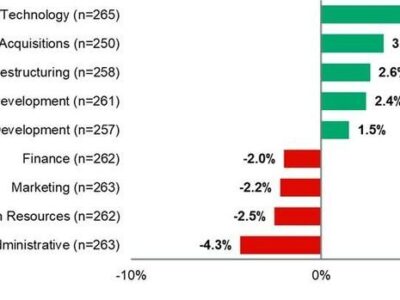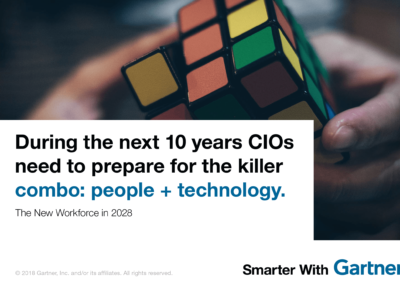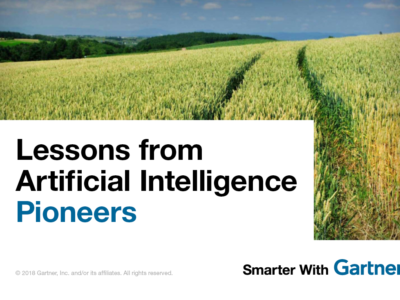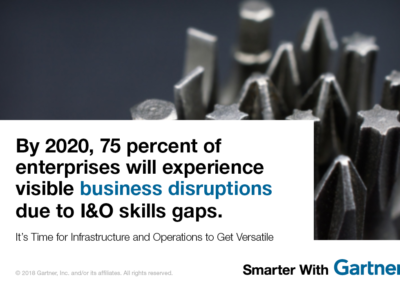Deep learning and natural-language generation will become standards in analytics
Machine conquered man when Google’s AlphaGO defeated the top professional Go player, but the evolution of deep learning didn’t end with the game. Baidu improved speech recognition from 89% to 99% and deep-learning jobs grew from practically zero jobs in 2014 to around 41,000 jobs today.
Deep learning is currently at the Peak of Inflated Expectations of the Gartner Hype Cycle, but its evolution from edge technology to a key component of analytics is one of five Gartner predictions for 2017.
Deep-learning jobs grew from practically zero to 41,000 jobs since 2014.
Despite seemingly endless promises in the world of data analytics, integrating the data can be a challenge. Automated tools such as deep learning and natural-language generation work well with the correct data, but if the data is not so easy to integrate, it will require professional data integrators and scientists to effectively use these new tools.
“We will see a blend of professional data integrators and data scientists — who can use this technology to become more efficient — along with a small army of citizen data scientists and citizen data integrators who will be recruited to fill more formal or semiformal roles,” said Peter Krensky, senior research analyst. “Data and analytics leaders should commit to leveraging a cross-functional team and the use of sandboxes to help reduce the risk that less-skilled workers will get into trouble.”
By 2018, deep learning (deep neural networks) will be a standard component in 80% of data scientists’ tool boxes.
Deep learning is becoming increasingly popular for both projects and hiring. Part of the rapid evolution is a result of big research labs such as Facebook and IBM investing in the research. In the business world, about 30% of data science platform vendors have the first version of deep learning in products.
But deep learning is not a stand-alone technology. In fact, it’s part of a third wave of analytics heralded by machine learning, and companies should look to machine learning as a potential service offering. Potential applications include anomaly detection, speech control and queries, sentiment analysis and facial recognition.
Data and analytics leaders should begin looking for potential opportunities to incorporate deep learning in the organization, specifically any critical business problems with significant “perceptual components.” Engage academics, research labs or consulting companies to learn more about deep learning. Consider potential startup acquisitions to acquire talent and technology.
By 2019, natural-language generation will be a standard feature of 90% of modern BI and analytics platforms.
Visualization has been a major driver of modern business intelligence (BI), but data in this form can be difficult to fully interpret. Natural-language generation (NLG) is able to create a written or spoken content-based narrative of data findings alongside the visualizations to produce a full story about key action items. Currently, BI teams integrate stand-alone NLG engines, but as the technology evolves, that will change. NLG will enable next-generation BI and analytics platforms to automatically find, visualize and narrate important findings. The technology will expand analytics to a broad audience as well as reduce time and cost for regular batch reports.
Data and analytics leaders should begin to integrate NLG with existing BI/data discovery and other tools. Monitor potential capabilities and roadmaps of BI, data discovery and data science, as well as emerging startups.
Get Smarter
Client Research
Gartner clients can view all five data and analytics predictions for 2017 in Predicts 2017: Analytics Strategy and Technology. This research is part of the Gartner Special Report “Predicts 2017: Lead, Follow, or Get Out of the Way: A Gartner Trend Insight Report,” a collection of research that focuses on predictions that enable companies to plan strategically for both expected and unexpected change.
Gartner Data & Analytics Summit
Gartner analysts will provide additional analysis on data and analytics leadership trends at the Gartner Data & Analytics Summit 2017, taking place February 20-21 in Sydney, March 6-9 in Grapevine, Texas, March 20-22 in London, March 23-24 in Tokyo, June 6-7 in Mumbai and June 20-21 in Sao Paulo, Brazil. Follow news and updates from the events on Twitter using #GartnerDA.
Data and Analytics Hub
Visit Gartner’s Data and Analytics hub for complimentary research and webinars.










